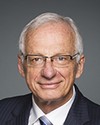I'm sorry, we're over time. Perhaps it will reprise in later conversation.
Right now I believe Ms. Gazan is going to speak for the NDP.
Evidence of meeting #22 for Indigenous and Northern Affairs in the 43rd Parliament, 2nd Session. (The original version is on Parliament’s site, as are the minutes.) The winning word was peoples.
A recording is available from Parliament.
Liberal

The Chair Liberal Bob Bratina
I'm sorry, we're over time. Perhaps it will reprise in later conversation.
Right now I believe Ms. Gazan is going to speak for the NDP.
NDP

Leah Gazan NDP Winnipeg Centre, MB
Yes, thank you, Mr. Chair.
My first question is for Madam Exner-Pirot.
You spoke about three years of uncertainty, because that's the maximum time provided in Bill C-15. You claim that it comes with a cost for investors. I'd like you to comment on risk disclosure in international trade rules, especially in relation to land claims. In this country, areas that are still under dispute, referring specifically to land claims.... Aren't we negotiating international trade deals, then, on a lie?
Research Advisor, Indigenous Resource Network
I wish I could answer your question. I'm not an investment expert, but I will just say that I think the action plan is an excellent vehicle. Dr. Gunn mentioned this too. I think lots of people would be happy if we could focus on the action plan, make the legislation follow an action plan and—
NDP

Leah Gazan NDP Winnipeg Centre, MB
I have a very limited amount of time. The reason I ask is that we know that risk disclosure is a warning you must provide investors, any investment, in terms of following law. I just wanted clarification on that.
My next question is for Ms. Gunn. The 1982 Constitution of Canada recognizes and affirms aboriginal and treaty rights, which is a general concept and has a level of ambiguity, and we know that. This has been a constant issue in defining the concept of aboriginal rights. Do you think that Bill C-15, which affirms the application of UNDRIP in Canada, will lessen this ambiguity?
Prof. Brenda Gunn
Thanks, Ms. Gazan, for your question. I'm going to try to answer it as quickly as I can.
There was included in the original Constitution the idea to try to negotiate additional understanding of section 35 through those constitutional round tables that were going to look at self-government, and those didn't succeed. We've had the very unfortunate situation in Canada where a broad general phrase, “aboriginal and treaty rights”, is what is protected in the Constitution, and with unsuccessful negotiations, you're right, it was left to the courts to determine. We continue to have litigation over the scope of these rights and some negotiations as well.
I do think that Bill C-15 and the UN declaration provide some useful supports, because they help flesh out that general understanding of what aboriginal treaty rights are. There's a whole list of rights that are included with the UN declaration that help us understand. I would just say, importantly, from my perspective, the inclusion of the economic, social and cultural rights as well as civil and political rights is really important, particularly when we think of indigenous women. I think the national inquiry as well as the B.C. inquiry into missing and murdered indigenous women highlight the way in which economic, social and cultural rights are particularly important for indigenous women and to ensure equality. We haven't seen as much success in litigating economic, social and cultural rights in either the Constitution or the Charter, so I do think there's a lot of clarity that can be gained through Bill C-15.
NDP

Leah Gazan NDP Winnipeg Centre, MB
Excellent. Thank you so much.
My next question is for Mr. Rodon. Many of the concerns that are raised are around FPIC. I'm wondering if you could share with the committee your understanding of FPIC versus veto.
Associate Professor, Department of Political Science, Université Laval, As an Individual
This is a question worth asking.
In my opinion, when we talk about a veto, it is because we want to defuse this issue politically. I don't think aboriginal people are looking to veto. What they're looking for is a relationship. Obviously, the right to say no is part of the relationship and the discussion, but the veto is used in situations where people say yes or no.
I think that prior consent, given freely and with full knowledge of the facts, is a relationship. In this relationship, it is up to the two players to find solutions to achieve the project. In some cases, the project will not be feasible. The case of Matoush, which involved a uranium mine on the territory of the Cree community of Mistissini, was documented.
In short, it is not really a veto. If it is perceived in this way, it is because it is seen as a power relationship, which is often the case at present, since this is how it happens. By having legislation, we get out of this veto logic. It is a matter of seeing whether the parties can agree. At the end of the process, which aims to obtain this consent, we can no longer speak of a veto, even if we have the right to say no, because a veto is a refusal that has been expressed from the outset on a question.
So that's the way to look at it. Everyone has something to gain from this. Often one of the very simple ways of getting aboriginal consent is to make them partners in the projects. We're seeing that more and more, and that's one way to deal with the veto issue.
Liberal
Liberal

The Chair Liberal Bob Bratina
Yes, I know.
We're at time now. We could suspend and arrange the next panel, and hopefully get to Mr. Saganash as well as our other guests, or we could continue on with a second round.
Do you have any preference, Mr. Schmale and Mr. Anandasangaree? We will extend the meeting as needed on a motion to extend later on, but what's your feeling right now?
Liberal

Gary Anandasangaree Liberal Scarborough—Rouge Park, ON
Mr. Chair, my sense is that if we are willing to extend by, say, half an hour, then I suggest we do a second round, a shorter round of maybe three minutes each to the Conservatives and Liberals, and then maybe a minute and a half to the NDP and the Bloc. We can then switch over.
Conservative
Liberal

The Chair Liberal Bob Bratina
Madame Bérubé? Ms. Gazan? Everybody? Okay.
We will continue on now.
Mr. Vidal, you're up, and we'll have three minutes for this round.
Conservative

Gary Vidal Conservative Desnethé—Missinippi—Churchill River, SK
Thank you, Mr. Chair.
We've heard a number of people reference the action plan today, so I want to go to Ms. Exner-Pirot and just quickly ask the following question.
My understanding is that the bill as it is now requires an action plan, as did Bill C-262, but the bill does not require the action plan to include any targets and/or deliverables. Professor Gunn, in her comments earlier, referenced a lost three years on the action plan since 2018. She also talked about that as the time and place to sort out many of the issues.
To me, it looks like maybe New Zealand has figured this out. They're doing the heavy lifting and putting their action plan in place before they implement the legislation.
Ms. Exner-Pirot, can you maybe explain, from your organization's perspective, what the value of putting the action plan before the legislation might be in addressing some of the uncertainty that you talked about in your investors?
Research Advisor, Indigenous Resource Network
Yes.
Not just investors, but also other indigenous organizations interested in resource development don't want that uncertainty. The general consensus from the people that we've been able to talk to is that the action plan would be a great vehicle. We have a lot of concrete ideas on things that can make it easier for indigenous people to attract capital, putting the “I” into ESG standards; procurement and things like that. I know our partners do too.
I think that the more the legislation makes clear that the action plan will fully articulate that there's a status quo until the action plan is agreed to, the better. Then you can have the consultation.
I know there's lots of concern that there hasn't been enough time, that this feels rushed, and I think that if there were an understanding that the action plan is the place where we can decide what's going to be different, what's going to change and what are going to be the practical implications of C-15, that would take care of a lot of people's concerns.
I'm sure that if you speak to other people in industry or pension plans, they might say the same thing, but certainly from the perspective of the indigenous organizations we're working with, they have lots of ideas for the action plan and prefer to see that be the vehicle.
Conservative

Gary Vidal Conservative Desnethé—Missinippi—Churchill River, SK
Thank you. I'll be really quick.
Professor Gunn, would you comment as well?
You made the reference to having lost three years. In all of this process would there have been anything preventing the government from starting the action plan so that by the time we got to this point three years down the road, the legislation would have a lot more certainty and clarity?
Prof. Brenda Gunn
I think practically, and you're in a better position to know how government works than perhaps I am, there was nothing. There were, of course, challenges that we see. We all put in a lot of time and effort into Bill C-262. It had made it through the House. It had made through many steps of the Senate as well. I think we had all anticipated it successfully entering into law. We all had to shift gears when it quickly died in the Senate.
I think reformulating an approach after that happened took time. I think importantly the reason why we can't just do an action plan first is that the UN declaration under rules in Canadian law does have relevance already and is being used by the courts. I think we want to as much as possible have a coordinated approach. While it's important for the UN declaration to be able to used in litigation where necessary, we don't want to rely on that.
I think I would flip the question to say, if we don't move and clarify this recognition of the application in Canadian law, we're leaving it to the courts to have that interpretation. It leads to more uncertainty and irregularities, for example, between the provincial courts and sometimes what we're seeing in the federal courts.
Liberal

The Chair Liberal Bob Bratina
Thank you for that. Thanks for trying to work to the time limits that we have.
Mr. van Koeverden, for three minutes.
Liberal

Adam van Koeverden Liberal Milton, ON
Thank you very much, Mr. Chair.
Thank you to all the witnesses. This has been extremely helpful for all of us. Thank you to many of you for your considerable work on this subject. To be totally honest, many of us are coming into this with fresh eyes. Your years of work and considerable effort on this are really helpful.
I have a question for Professor Gunn, first. It does come back to the framing of free, prior and informed consent as a veto. I think the word veto has a definition. Perhaps free, prior and informed consent might be a little bit more ambiguous. I'm really concerned with the conflation of those two. I would love a little bit more insight on that.
Since I will probably just ask one question, could you provide a little bit of insight on participation and the ability to say no. I believe that full participation includes the ability to say no.
Thank you.
Prof. Brenda Gunn
Thanks.
I think its really important to remember again that the UN declaration didn't just pop out of nowhere. This goes back to member Battiste's question.
There's actually 20 years of jurisprudence and studies that have happened at the international level that help us understand the UN declaration. While we say in Canada we don't know it, it's only because we haven't looked. I'm happy to provide this committee with various studies that have happened that have really fleshed out. I can provide decisions on how the UN is understanding free, prior and informed consent.
We focus a lot on consent. Consent is really included to ensure that indigenous peoples who have a really good understanding of their rights are involved in decision-making where their rights are specifically and especially impacted. I think you're absolutely right to connect free, prior and informed consent to the right of indigenous peoples to participate in decision-making. The idea internationally is that indigenous peoples' inclusion, including gaining their free, prior and informed consent, helps us to make better decisions, ones that are going to stand.
I think, finally, this idea of a veto or not veto suggests that we're not having a conversation. This is where it's important to remember that we also have free, prior and informed. The whole idea when you use those four concepts together is about making sure that indigenous peoples are there, are engaged in the process, and can provide the necessary information. It's making sure that there is this idea of a back and forth conversation where we can understand the concerns that might be addressed, have opportunities to try to address them, and work together to come to a resolution. That's the understanding of the package of free, prior and informed consent.
Liberal
Liberal

Adam van Koeverden Liberal Milton, ON
I'll give it back to the chair, considering that we're on a tight schedule.
Thank you very much.
Merci, Professor Gunn.